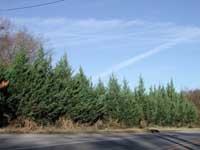Resource Library
Plant of the Week: Leyland Cypress
The University of Arkansas System Division of Agriculture does not promote, support or recommend plants featured in "Plant of the Week." Please consult your local Extension office for plants suitable for your region.
Plant of the Week
Leyland Cypress
Latin: Cupressocyparis leylandii

Moderation is a good thing, even when it comes to plants. Gardeners across the southeastern states showed no moderation when they planted all of those red tip photinia hedges to screen the boundaries of their properties.
Then, when they became diseased and had to be replaced, they again lacked restraint. But this time, instead of a large shrub, they replanted en mass with an evergreen tree, the Leyland cypress.
Leyland cypress (x Cupressocyparis leylandii) is a 120-foot tall forest giant that has been promoted extensively as a coniferous evergreen screen. While it will tolerate continual shearing and it’s possible to keep its size under control, it often escapes. Once a conifer overgrows its site your choices are removal or to let it grow. And grow it will.
Leyland cypress is a bigeneric hybrid (the reason for the “x” before the Latin name) between Monterey cypress (Cupressus macrocarpa) and the Alaskan cedar (Chamaecyparis nootkatensis) that occurred accidentally on a Welch estate in 1892. It has graceful, green foliage reminiscent of an arborvitae. It grows with a strong central leader and is usually tall and narrow in form. Young plants are Christmas tree shaped; older trees have a more elongated profile.
The plant is named after Christopher Leyland, the brother-in-law of the estate owner where the first and second accidental crossings occurred (a second time in 1911). Leyland, recognizing them as fast growing and different, took the original trees back to his estate south of Edinburgh, Scotland. In 1926, specimens were collected and officially recognized as botanically unique and given a name.
All of the 20 clones of Leyland cypress now grown originated from one of the 11 trees produced from the three known accidental couplings of these two species. Leyland cypress first began being propagated in the 1930s, and since then, green, grey, blue and golden forms have been selected. Because these are sterile hybrids, they produce neither pollen nor seeds.
Leyland cypress cuttings were brought to California in 1941. In 1965, Dr. Roland Schoeniker, a forester for Clemson University, began looking at it as a possible Christmas tree for the southeast. In 1980, it made its debut in Wayside Gardens’ mail order catalog, a firm with a reputation as a source for many new plants. Because it seemed to require little care and grew fast, its popularity quickly increased.
But by the end of the 20th century it had lost much of its luster. People realized how hard it is to keep a tree capable of growing 120 feet tall pruned as a 6-foot tall hedge. And, by this time, its susceptibility to bagworms and a canker disease was recognized. Kim Tripp and J. C. Raulston, writing in 1995 in North Carolina, only mentioned Leyland cypress in negative terms, omitting it from their list of recommended garden plants.
Size is the real concern of this plant. It’s too big and too vigorous to ever seriously consider using as a hedge. The British government estimates there are up to 17,000 unresolved disputes over excessive shading by too-tall hedges, most of them from the ubiquitous “leylandii.” Hedgeline, a group advocating ordinances restricting the use of overly tall hedging material, says it’s closer to 100,000.
Leyland cypress is adaptable to a wide range of soil characteristics and, once established, has reasonably good drought tolerance. It’s best in full sun but will grow under a high canopy of shade. The canker disease and bagworm problems are real, but the size of the plants is probably the most important thing to consider before planting this giant.
By: Gerald Klingaman, retired
Extension Horticulturist - Ornamentals
Extension News - February 3, 2006
The University of Arkansas System Division of Agriculture does not maintain lists of retail outlets where these plants can be purchased. Please check your local nursery or other retail outlets to ask about the availability of these plants for your growing area.